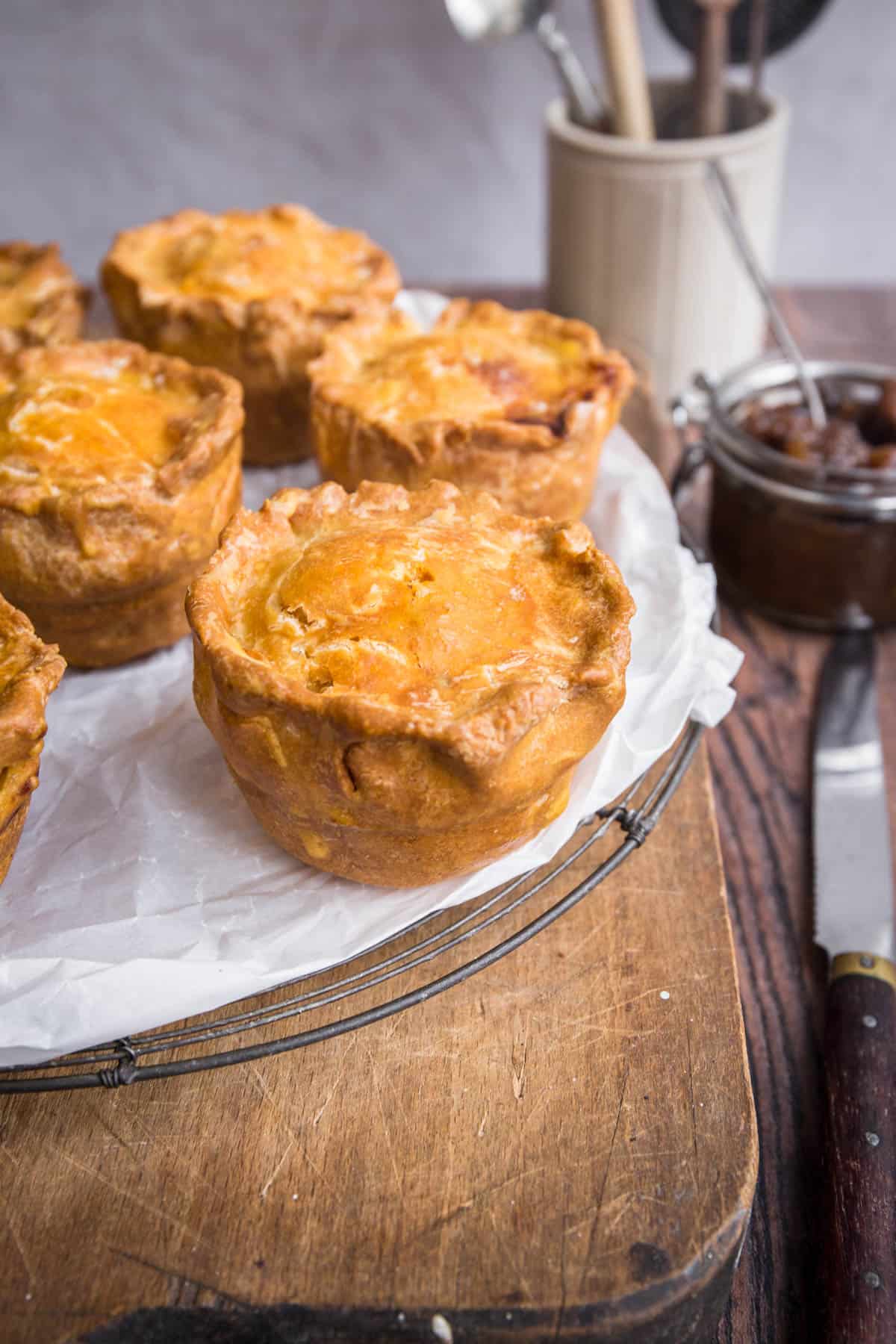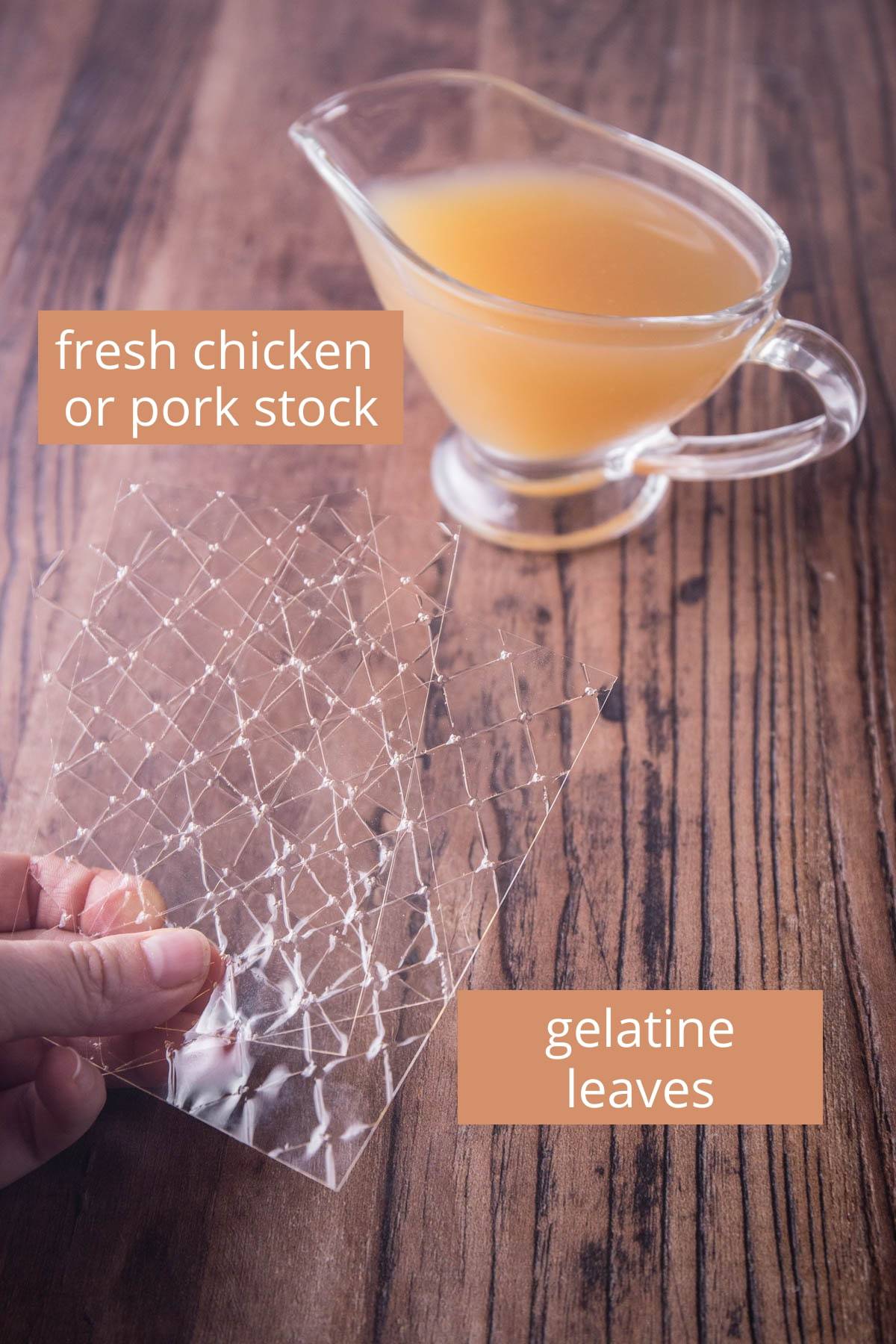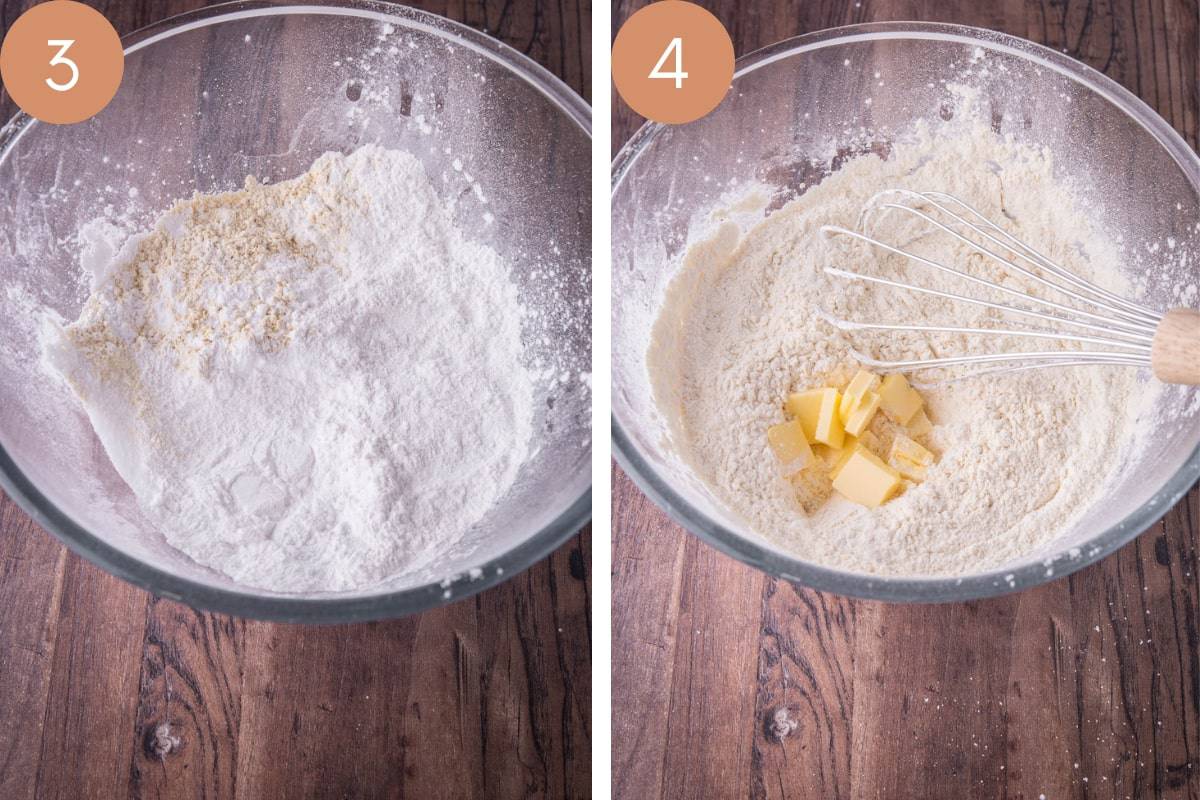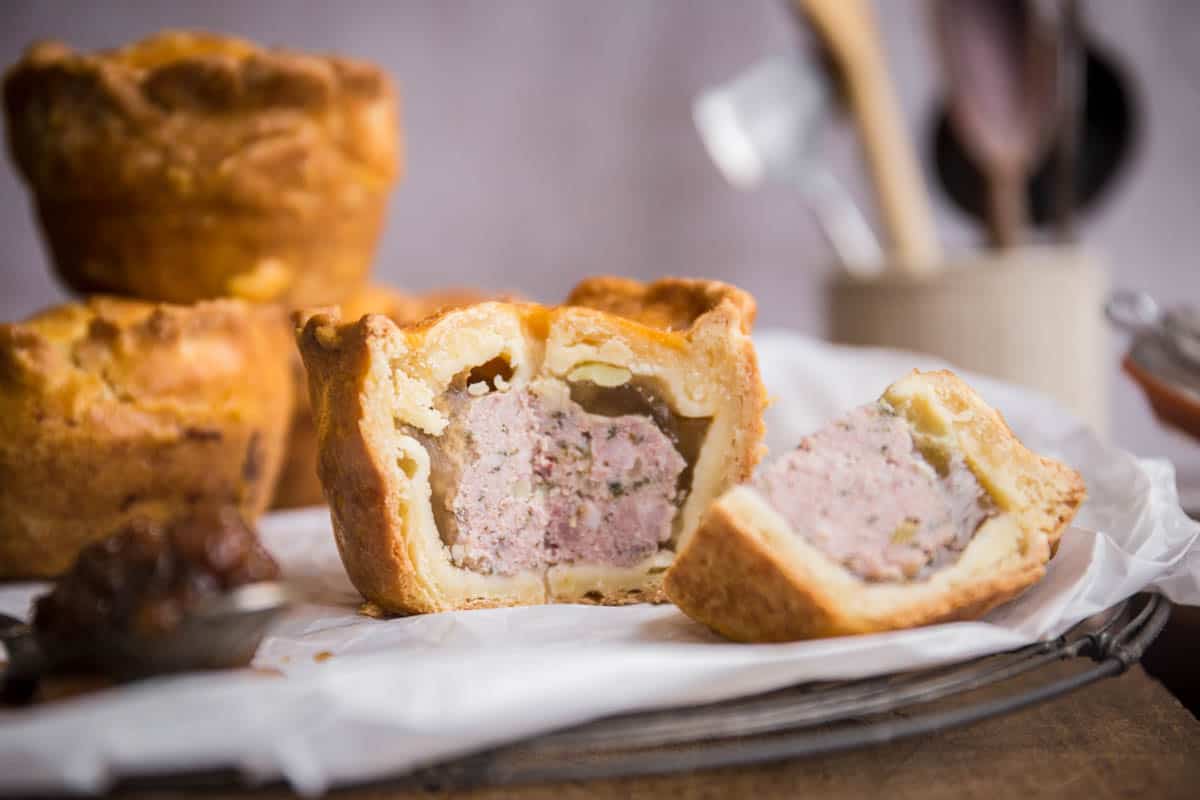This post contains affiliate links. Please read my disclosures.
These Gluten-Free Pork Pies are surprisingly easy to make with a flavourful gluten-free hot water crust pastry that is easy to work with and needs no xanthan gum. The pork meat filling is juicy and perfectly seasoned. A proper traditional pork pie which no one would guess was gluten-free.
Jump to:
- Why you’ll love this recipe
- Watch the video to see how to make the recipe
- What is Hot Water Crust Pastry?
- What part of the pig is pork pie?
- What is the jelly in a pork pie made of?
- Why do they put gelatin in pork pies?
- How do you eat a British pork pie?
- What gluten-free flours are required for the pastry
- Full list of ingredients
- How to make gluten-free pork pies
- Tips for best results
- How to avoid the pork pies from sticking to the tin
- How to fill your pork pies with jelly
- Shop the recipe
- Make ahead
- How to freeze
- How to serve mini pork pies
- What goes with pork pie?
- Gluten-Free Pork Pie
Did you adore a good mini Melton Mowbray pork pie? It’s a quintessential British picnic food and until I developed this Gluten-Free Pork Pie recipe I hadn’t had one for years. And to be honest I don’t remember even Melton Mowbrays tasting this good! If you have never tried a homemade gluten-free pork pie before then you will be astounded at the difference.
For these Traditional British Pork Pies we enjoy thick crisp and buttery pastry encasing juicy pork with so much flavour and a thin border of richly flavoured jelly giving this buffet favourite a new lease of life.
This recipe forms the pork pie in a muffin tin but actually I have tested the recipe using the old fashioned hand raised pork pies method where you form the pastry case around the pork filling. It does work, although the finished pie wasn’t as high and looked much more rustic.

Why you’ll love this recipe
- Perfectly seasoned pork filling with fresh herbs and spices.
- Three different cuts of pork give the most succulent feel and taste.
- This gluten-free hot water crust pastry has incredible flavour thanks to using gram flour in our flour blend.
- This pastry uses butter alongside the lard. Butter for flavour and lard for stability.
- Our gluten-free hot water crust pastry is easy to handle with good elasticity and rolls out well.
- Surprisingly quick and straightforward to make. They can be whipped together and put in the oven in about an hour. Then 40 minutes of baking time, 30 minutes of hands off resting, 10 minutes to fill with jelly and then a final overnight chill.
- No need for xanthan gum. READ MORE >>> Why I don't bake with xanthan gum.
Watch the video to see how to make the recipe
What is Hot Water Crust Pastry?
This is a classic pastry recipe used primarily for hand raised pies which are eaten cold. Think traditional pork pies, meat pies or vegetarian pies which always look beautifully rustic due to their handmade nature.
The gluten-free hot water pastry dough is made with warm ingredients and needs to be brought together quickly to avoid it cooling and drying out. Preferably the pastry should be formed around the pork and placed in the oven still warm (although I never managed to work that quickly!)

What part of the pig is pork pie?
You want the chosen pork cut to be slightly fatty. For my first couple of tests of this recipe I used a lean pork shoulder with streaky bacon but my husband, being the total pork pie connoisseur suggested that you do need more fat in the mix.
So for the final version of these homemade gluten-free pork pies we use a mixture of pork shoulder, pork belly and smoked streaky bacon for flavour. And I totally agree, having that pork belly in the mix is essential to make the pork filling a little softer and juicy.
What is the jelly in a pork pie made of?
Traditionally the jelly would be made with a boiled pigs trotter. However, in this recipe we cheat a little and use chicken stock set with gelatine. It’s a lot quicker.
Although you must use fresh chicken stock in this instance – a stock cube wouldn’t feel right at all. A good quality stock from the supermarket or your local butcher works well if you don’t have any homemade to hand.
Why do they put gelatin in pork pies?
Traditionally jelly is poured into the cooked pork pie to help with preserving the pie for longer.
As the pork pie cools the pork filling shrinks away from the sides of the pastry. The jelly plugs up the gaps, helping to preserve the pie and giving it more moisture.
When I was younger I couldn’t bear the jelly in pork pies but actually if you use proper fresh chicken stock to make the jelly it is incredibly flavourful and adds another dimension to the pie.
You could leave the jelly out but all of our taste testers agreed that the jelly was an essential part of it and made the whole pork pie tastes so much better.
How do you eat a British pork pie?
Pork Pies are excellent for a lunch with salad and pickles. If you are on a lovely summer picnic then these mini pork pies are excellent to eat with your hands.
However, if you are having a perfectly civilised lunch at the dining table then equally the pork pie is deliciously eaten using cutlery which also helps when you want to pile on your homemade pickles and chutneys.
What gluten-free flours are required for the pastry
To make this gluten-free hot water crust pastry you need to use 3 single origin flours blended together to create your mix. These provide the necessary structure and texture which is needed in this traditional pork pie pastry. And using this homemade blend also means you don’t need to use any xanthan gum.
Gram flour (chickpea flour, garbanzo flour)
This legume flour has a high protein content so gives our pastry a great elasticity which means it will roll out with ease and minimal breaking. It imparts a lovely rich yellow colour to the pastry which make our pork pies look so appetising. Plus the flavour this flour gives the pastry is wonderful and is a perfect match for the pie.
For this recipe I do not recommend substituting this flour for another.
Sweet rice flour
This starchy flour is also known as glutinous rice flour, even though it contains no xanthan gum. It is not to be confused with regular rice flour. It binds really well and gives the pastry a good stretch and great structure.
For this recipe I do not recommend substituting this flour for another.
READ MORE >>> The Ultimate Guide to Sweet Rice Flour
Tapioca flour (starch)
Another starchy flour which is another great binder. It balances out the sweet rice flour and also helps gives our pastry a lovely golden colour.
READ MORE >>> The Ultimate Guide to Tapioca Flour
Substitution: You can use arrowroot powder instead of tapioca starch
Can you use all-purpose gluten-free flour instead?
I don’t recommend it for this recipe. Shop bought gluten-free flours vary wildly in which flours are included in the blend. This recipe has a perfectly balanced mix of flours which give a texture that is perfectly elastic, easy to handle with minimum breakage. It has a good structure that has no need for xanthan gum.
Full list of ingredients
Pork filling

- Pork shoulder.
- Pork belly.
- Smoked streaky bacon.
- Sage.
- Parsley.
- Ground nutmeg.
- Ground allspice.
- Ground mace.
- Salt and pepper.
Gluten-free hot water crust pastry

- Gram flour. (chickpea flour or garbanzo flour).
- Sweet rice flour. (glutinous rice flour). Do not substitute with regular rice flour.
- Tapioca flour. (tapioca starch).
- Unsalted butter.
- Lard.
- Whole milk.
- Eggs. This recipe was tested with medium sized eggs. 60g each with shell, 50g each without shell.
- Salt. This recipe uses kosher salt.
Jelly

- Good quality fresh stock. Chicken stock is the most widely available and what I used but pork stock is the more traditional choice. Just make sure it is fresh stock and not from a stock cube if possible.
- Gelatine. This recipe was tested with Platinum Grade Leaf Gelatine.
How to make gluten-free pork pies
Make the pork pies the day before serving as the gelatine will need time to set overnight.
For full recipe instructions go to the recipe card at the end of this post.
How to make the pork filling
- Place the pork with all the filling ingredients into a food processor and mix until totally minced and smooth.
- Form into 8 balls and store in the fridge until needed.
- Weigh out the mixed pork filling into equal sized balls (about 45-50g each) and chill in the fridge until you are ready to fill your pies.

How to make gluten-free hot water pastry dough
- Mix together the gram flour, sweet rice flour and tapioca starch in a bowl. Rub in the butter to form breadcrumbs.
- Heat the lard and milk until the lard has melted.
- Pour into the flour mixture and combine.
- Add the egg whites and bring together to form a smooth dough.
It may seem like the pastry is incredibly sticky at first but don’t worry it will start coming together into a smooth ball as you continue bringing it together.





How to make the pies
- Roll out the pastry in batches in between two sheets of baking parchment.
- Cut out 8 large rounds for the base and 8 smaller rounds for the lid.
- Fit the large rounds in the holes of a large muffin tin (with the bottom of each lined with baking parchment).
- Place a ball of pork filling into each pastry case, brush the edges with egg yolk then fit over the pastry lid, sealing together well. Crimp the edges to look pretty.
- Make a hole in the centre of each pie then brush the surface with the egg yolk.
- Bake for 30 minutes.
- Remove the pies from the muffin tin. Brush the sides with egg yolk, place on a parchment lined baking tray and bake for a final 10 minutes.
- Remove from the oven and leave to rest for at least 30 minutes before filling with jelly.


Tips for best results
- Work very quickly with the pastry as it dries out quickly.
- Roll out the pastry in batches so you can rest the pastry you are not currently working with in a parcel of baking parchment. This helps to keep the pastry warm and avoids it drying out too much.
- By rolling the pastry out in between baking parchment you do not need to add any extra flour and it won’t stick to the rolling pin.
- You can roll and re-roll the pastry as often as you need.
- Roll out the pastry to about 5-6mm thickness as this will ensure a strong hold for your meat filling.
- When you are cutting out the pastry rounds, tear the surrounding pastry away from your rounds so you can pick up your circles of pastry neatly.
- Test your pork is cooked with a digital thermometer probe –75C.
How to avoid the pork pies from sticking to the tin
It is important to ensure your pies don’t stick to the tin as there is nothing more disappointing than lifting out your pies after the bake to leave most of the pie behind in the tin.
There are several ways to avoid this:
- You must use a good quality muffin tin. I find the anodised silver ones are the best and I have the most success with my bakes not sticking to these tins.
- For these Gluten-Free Pork Pies you actually need to line the muffin tin holes with a circle of baking parchment at the bottom. This pastry is quite sticky and has a tendency to stick to the bottom of the tin otherwise. Use a 6cm pastry or cookie cutter to draw round on the baking parchment before cutting out and lining. You only need to cut out the circles once if you fold leaves of baking parchment underneath your template and cut them all out together.
- You don’t want any meat juices to leak out down the sides of the tin, they will caramelise and act like glue to your baking tin. Avoid this by making sure your pastry is nice and thick so there is no potential cracking.
- Make sure you have joined the lid and the sides of the pastry together completely. The weakest part of the pastry is at the join of the pastry lid. Bring the pastry base up and over the pastry lid. Patch up any potential weak joins with more pastry.
- When you are shaping the top of the pies you can bring them away slightly from the round edges of the muffin tin to help avoid sticking to these edges during the bake.
- Try not to let any egg wash run down the sides of the pies when you are glazing them in the muffin tin, again this will help them not to stick.
How to fill your pork pies with jelly

Soak the gelatine leaves in room temperature water for a few minutes, then squeeze out the water and mix into warm stock to dissolve.
Once you have dissolved the gelatine in the stock then you can pour the warm stock through a very thin funnel into the pork pie. You can stick the funnel in through the central hole which you made for the initial bake and pour the stock into the middle of the pork pie.
Pour slowly and carefully.
You know enough stock has been added into the pork pie as it doesn’t leak out of the bottom of the pie and the stock seems to disappear into the pork pie. Eventually the stock will come back up through the funnel when the pie has been filled.
If for some reason the stock is being blocked from accessing the gaps in the pie (maybe the filling is too close to the pastry lid) then you can make another hole on the top edge of the pork pie, feeling for the gap between the filling and the pastry wall. I often have more success filling up the pork pies here.
Shop the recipe
 Buy Now →
Buy Now →  Buy Now →
Buy Now →  Buy Now →
Buy Now →  Buy Now →
Buy Now →  Buy Now →
Buy Now →  Buy Now →
Buy Now →  Buy Now →
Buy Now → 
Extra large Chef Grade Pastry Cutters
Buy Now → Buy Now →
Buy Now → Make ahead
It is essential to make the pork pies (at least) the day before you want to serve them as you need to rest them for at least 8 hours which gives the gelatine time to set properly.
The pork pies will keep well chilled in the fridge for up to 5 days.

How to freeze
Allow the gelatine time to settle in the pork pie and the pie to cool to room temperature, so at least 8 hours after you have baked them. Wrap well in plastic wrap and store in an airtight container for up to 2 months in the fridge.
Allow to thaw completely at room temperature overnight before serving.

How to serve mini pork pies
Pork Pies make a delicious addition to a picnic as they are very transportable. They are also lovely as part of a ploughmans lunch or part of a buffet table.
What goes with pork pie?
Cheese and crudites go really well if you want to make the pork pie more than just a quick snack. However you mustn’t forget the obligatory condiments:
- Homemade Brown Sauce
- Pickled Golden Beetroot
- Piccalilli
- Ale Chutney
- Apple Ginger Chutney
- Plum Beetroot Chutney
- Mango Chutney
I urge you to give this Gluten-Free Pork Pie recipe a try. If you do then please leave a comment below and give the recipe a rating which helps others find the recipe on Google. If you then go on to use this recipe as a launch pad for your own culinary creation then I’d also love it if you’d share it and tag me on Instagram. It is so lovely for me to see your versions and variations of my recipes.

Gluten-Free Pork Pie
Ingredients
Pork Filling
- 150 g pork shoulder
- 150 g pork belly - skin removed
- 100 g smoked streaky bacon - about 6 rashers – you can use unsmoked
- 5 leaves fresh sage
- 1 handful fresh parsley
- ⅛ teaspoon ground nutmeg
- ⅛ teaspoon ground allspice
- ⅛ teaspoon ground mace
- ⅛ teaspoon ground black pepper
- ¼ teaspoon salt
Hot Water Crust Pastry
- 200 g gram flour - chickpea flour, garbanzo flour
- 160 g sweet rice flour - glutinous rice flour
- 125 g tapioca flour - tapioca starch
- ½ teaspoon salt
- 75 g unsalted butter - cold from the fridge
- 75 g pork lard - diced
- 125 ml whole milk
- 5 eggs - medium, separated, see notes
Jelly
- 200 ml fresh chicken stock
- 3 gelatine leaves
Instructions
Pork Filling
- Add the pork and bacon into a food processor with all the filling ingredients.
- Mix together until the filling is totally minced up.
- Weigh out and shape the pork filling into 8 balls of about 45-50g each.
- Rest on a plate in the fridge whilst you prepare the pastry.
Hot Water Crust Pastry
- Pre-heat oven to 190C / 170C fan assisted oven / gas mark 5.
- Cut out 8 circles of baking parchment to fit in the bottom of 8 holes of a large muffin tin.
- Whisk the flours with the salt in a large mixing bowl.
- Add the butter and mix in with your fingertips to make a breadcrumb texture.
- Pour the milk and lard into a small saucepan. Heat until the lard has just melted then remove from the heat.
- Pour the warmed milk mixture over the flour and mix with a wooden spoon to create larger shaggier breadcrumbs.
- Add the egg whites and bring together to form a dough, at first with the wooden spoon then switch to use your hands.
- Tip out onto a work surface and use your hands to make a cohesive smooth dough ball.
Making The Pies
- Roll out the dough one quarter at a time. Storing the dough you are not using wrapped in baking parchment to stop it drying out. Roll the pastry into a large circle in between two sheets of baking parchment.
- Cut out 6mm rounds of pastry using a 11cm round pastry cutter. Continue rolling out the dough until you have 8 rounds.
- Carefully fit the rounds into the muffin tin holes that are lined at the bottom with parchment. The pastry should be overhanging the top of the holes.
- Place a ball of the meat filling into each pastry base.
- Roll out the rest of the pastry in between baking parchment then cut out 8 x pastry rounds using an 8cm round pastry cutter.
- Whisk together the egg yolks and brush over the lip of the pastry base using a silicone pastry brush.
- Place a pastry top over each pie then seal well. You can crimp together using your forefingers.
- Bring the top of the pie away slightly from the corner edge of the muffin tin to avoid the pies sticking to the tin.
- Make a hole in the centre of each pie with a skewer. Then brush the top surface of each pie with the egg yolks. Re-make the holes if necessary.
- Bake the pies for 30 minutes in the centre of the oven.
- Remove the hot pies carefully from the muffin tin (and the baking parchment) and place on a baking sheet lined with fresh baking parchment. Brush the sides of each pie with more egg yolk and bake for further 10 minutes. Using the hole in the top of the pie double check the meat is thoroughly cooked by testing the temperature with a meat probe. The temperature should be 75C.
- Remove the pies from the oven and allow to rest for 30 minutes before adding the jelly.
Jelly
- Place the gelatine in cold water for 3-5 minutes to soften.
- Pour the chicken stock into a small saucepan and heat for a minute until warm.
- Remove the gelatine, squeezing out the excess water, and whisk into the warm chicken stock until dissolved. Remove from the heat and allow to cool for 1 minute.
- Make a hole in the surface of the pie using a skewer. Try to position it between the side of the pastry and the meat filling where there will be a gap for the jelly to go.
- Use a small funnel (or piping bag fitted with a small piping nozzle or even a syringe) to pour the chicken stock into each pork pie. You know when the pie is filled as the jelly will start to spill out of the hole.
- Place the pies back into the fridge to chill for at least 8 hours, or overnight before serving.
Video
Notes
Ingredient substitutions
The eggs used in this recipe are medium size, 60g with shell and 50g without shell. If you can't get hold of medium eggs I suggest you weigh the amount. I do not recommend substituting any of the gluten-free flours in this recipe. It was tested with several different flour combinations and this final version really was the most effective.Is the jelly optional?
Kind of. You could leave the jelly out but all of our taste testers agreed that the jelly was an essential part of it and made the whole pork pie tastes so much better, giving it more moisture and flavour.Tips and troubleshooting
For this recipe I really recommend reading the full post above for a detailed explanation on all the steps of this recipe.- The pastry will seem incredibly sticky when you first make it. Continue to roll it into a smooth ball and the stickiness soon subsides.
- In fact, the pastry dries out quickly so any you are not working with should be wrapped in baking parchment.
- Avoid the pork pies from sticking to the tin by lining the muffin tin with a circle of baking parchment at the bottom of each. Also make sure your pastry base is sealed properly to the pastry lid. Bring the filled pie away slightly from the round edges of the muffin tin and don’t let the egg wash drip down the sides of the pies.



Leave a Reply